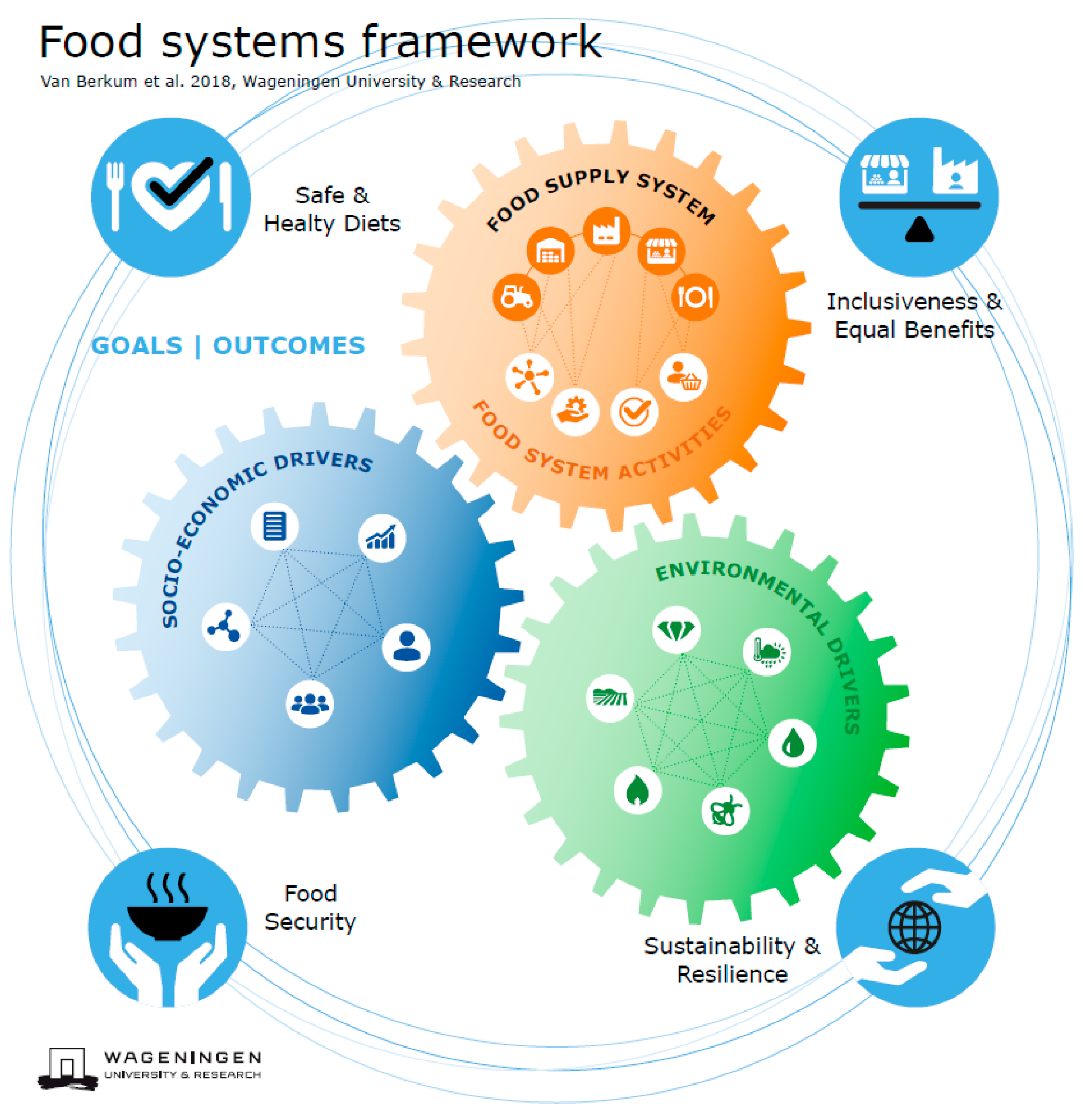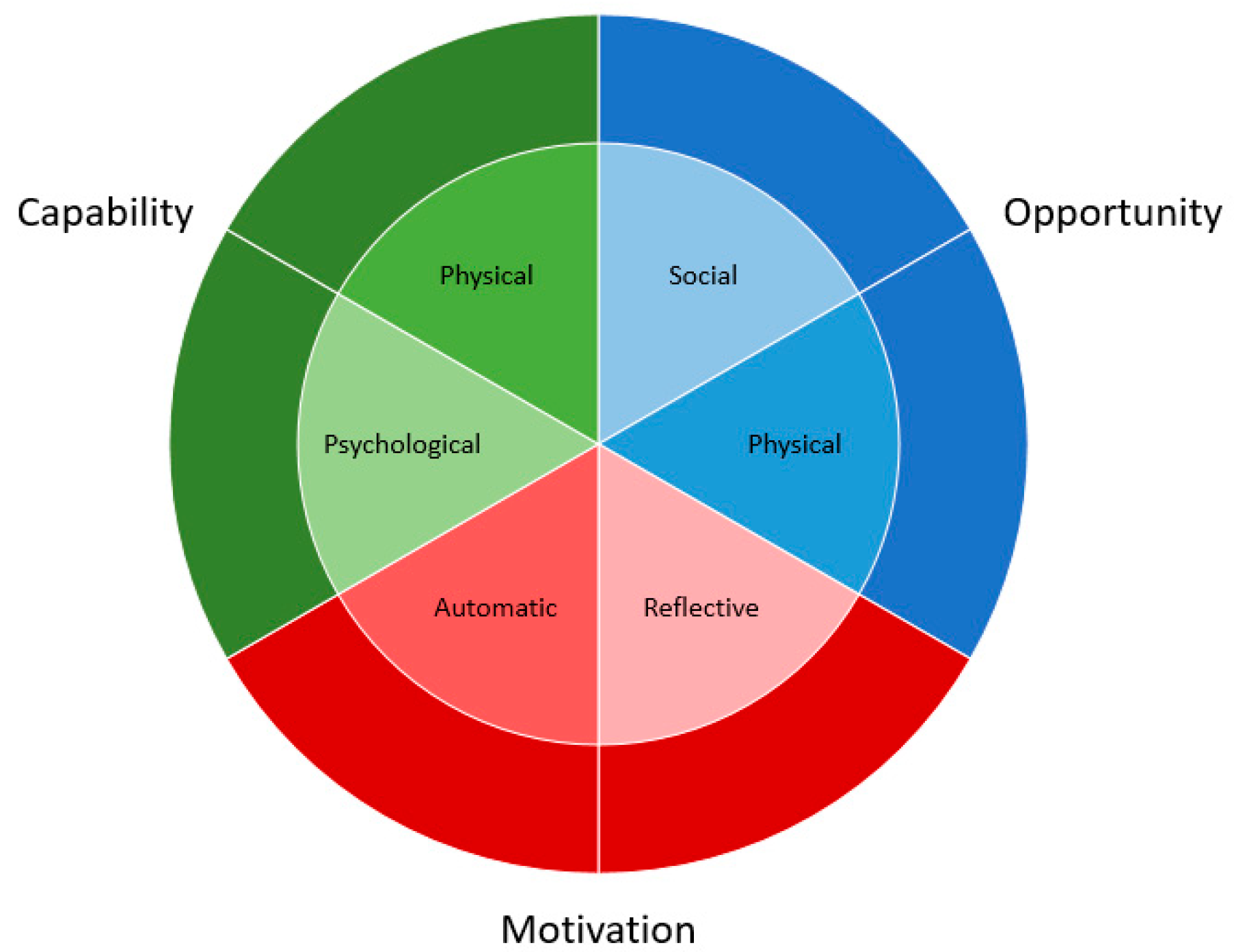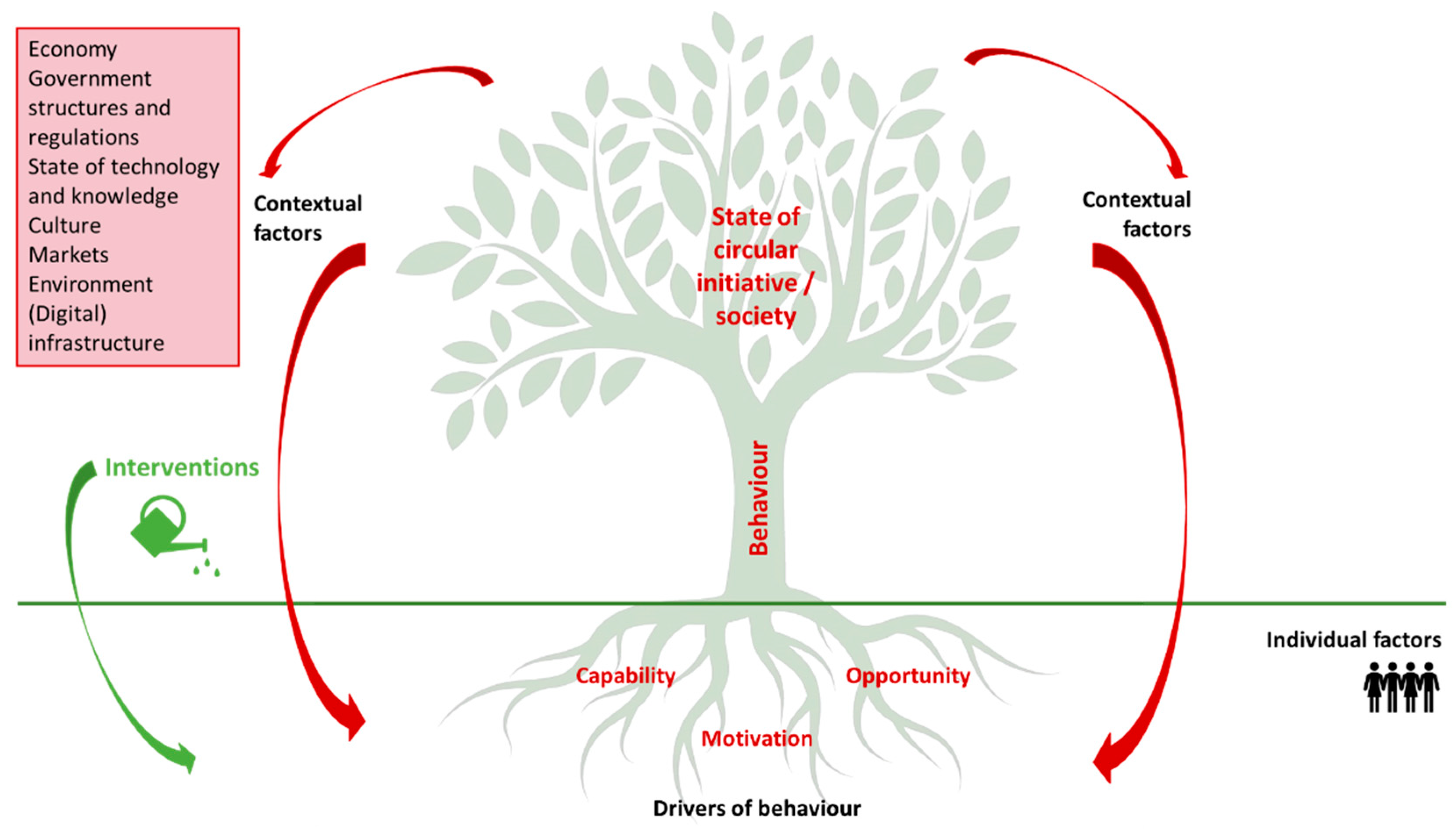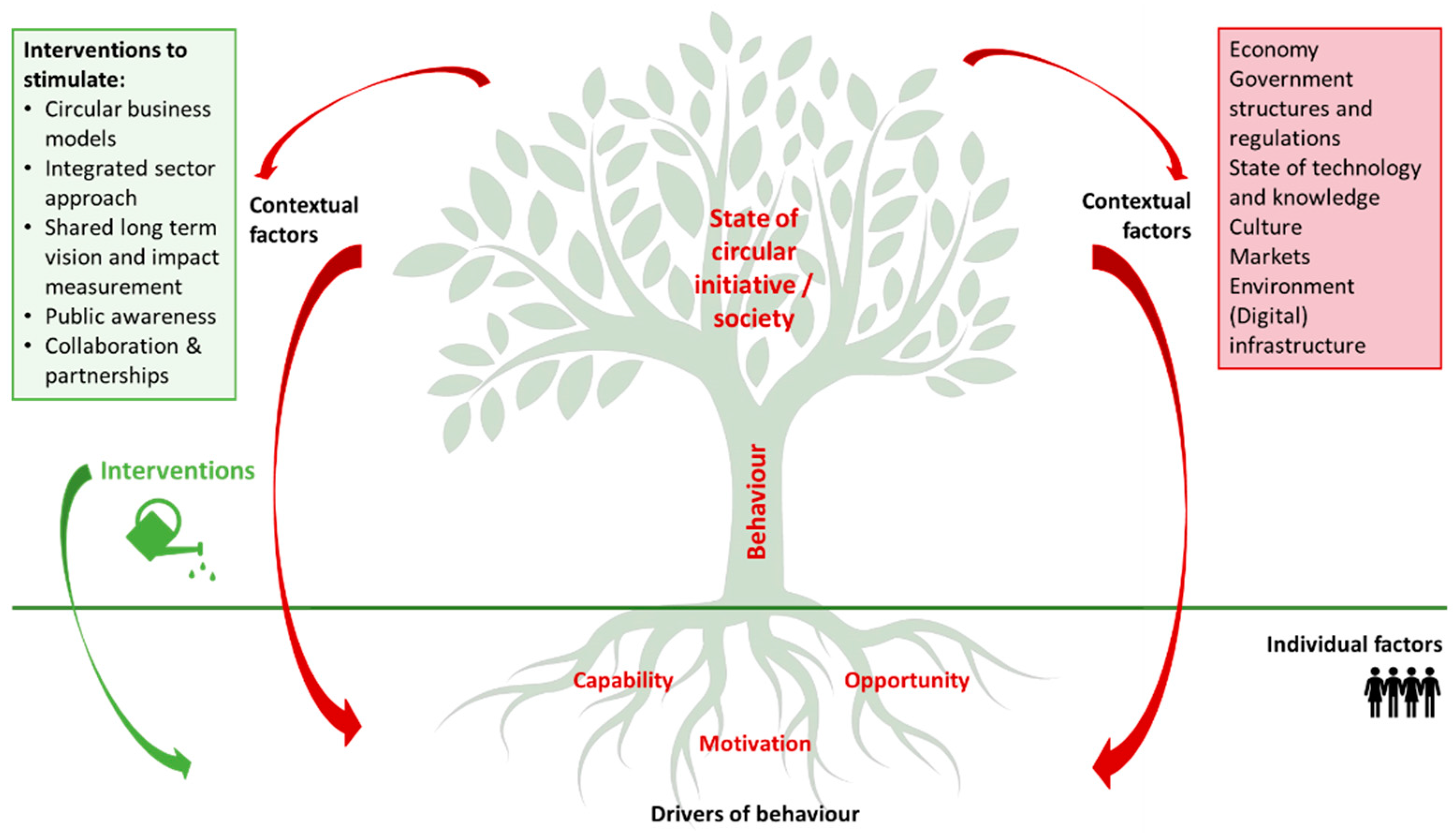Moving from Niche to Norm: Lessons from Food Waste Initiatives
Abstract
:1. Introduction
- Efficient use of raw materials (reduce)
- Use renewable resources to produce new raw materials (reuse)
- Develop circular production processes and products (recycle)
2. Materials and Methods
- A comprehensive literature review has been carried out to identify personal and contextual drivers and barriers affecting the transition to CE.
- The identified personal and contextual drivers and barriers have been combined with the elements from the Behavioural Change Wheel [4] for an adapted framework which offers a new perspective on behavioural change towards CE.
- For the analysis, a case study on reducing food losses and waste (FLW) has been chosen as part of a circular food system. Within this case study, five initiatives that aim at food waste reduction in the food supply chain, under the umbrella of the Dutch initiative “United against food waste” (STV), as a part of the national FLW reduction strategy in the Netherlands, have been selected. In total, eight in-depth semi-structured interviews have been carried out with both the initiators and the participants of these five different initiatives.
- The last step provides the analysis of the results and the implications of the findings.
Case Study Approach and Analysis
3. Theory: Incentivising Behaviour Change for a Circular Economy
3.1. Behaviour Change in the Systems Perspective
3.2. Transition to a Circular Economy: Transition Thinking
3.3. Transition to a Circular Economy: Drivers and Barriers
3.3.1. Personal and Contextual Drivers and Barriers of CE
- Lack of skills and investment possibilities;
- Current pricing levels which do not provide incentives for efficient resource use;
- Lack of incentives, for example due to insufficient internalisation of externalities through policy or other measures;
- Lack of alignment of power and incentives between system actors;
- Limited consumer and business acceptance of circular business models;
- Limited information, know-how and economic incentives on technical/practical options for circular food systems;
- Lack of consumer awareness (e.g., perishability of food products);
- Insufficient investment in new infrastructure, innovation and technologies (partly due to a lock-in of existing technologies and infrastructure);
- Challenges in obtaining suitable financing for such investment;
- Financial –measuring financial benefits of CE, financial profitability (e.g., difficulties in measuring benefits, since the shift towards CE requires far-reaching changes which take time and investments, while the logic in the financial system is focused on rapid returns on investments and cost-savings);
- Structural—exchange of information, unclear responsibility;
- Operational—infrastructure/supply chain management;
- Attitudinal—perception of sustainability, risk aversion;
- Technological—product design, incorporation into production process.
- Policy and economy—governmental laws in different countries promoting cleaner production, consumption, and end of life management in order to secure resources, health and safety;
- Health—refers to increasing animal and public health. “Health is not everything, but without health, everything is nothing”. Many people suffer from illnesses caused by dirty air and water;
- Environmental protection—Climate changes due to the waste produced, greenhouse gas emissions, losses of unique landscapes, bad air and water quality;
- Society—on one side, an increasing global population, resulting in increased consumption demanding more resources; on the other side, consumers’ environmental awareness places pressure on industries to develop CE;
- Product development—improves the efficiency of the materials and energy use in the supply chain and increases the value of products by increasing their quality.
3.3.2. Behavioural Perspective
3.3.3. Transition to a Circular Economy: Interventions
3.4. Behaviour Change Perspectives: A New Framework
- Roots and stem—Observed behaviour (stem) is the result of a combination of capabilities, opportunities and motivations (roots). This combination is person- and context-specific, as it contains both personal factors (i.e., motivation, drive) as well as context-related factors (i.e., opportunity, such as the means to make certain choices);
- Soil and environment—The mix of capabilities, opportunities and motivations is largely a result of the system of which an individual is part. This system consists of socio-economic as well as environmental drivers. People’s capabilities, opportunities and motivations are affected by the social networks they are part of, coming with a shared culture and norms, as well as by the market infrastructure, the state of science and technology, political economy and the climate—to name only a few.
- Tree-top—behavioural change leads to observed behavioural outcomes. When shared by a critical mass, these outcomes may lead to (new) shared norms. The behavioural outcomes are not isolated from the environment but will in turn affect socio-economic as well as environmental conditions. These, in turn, will nurture future decision making, in an ongoing cycle.
- Inputs & instruments—Once the drivers of behaviour are clear, and it is understood what the bottlenecks for the desired behaviour are, it becomes clearer what instruments could be effective for incentivising the desired behaviour. These instruments can be tailored to serve capabilities, opportunities or motivations, or a combination of these. It is important to realise that the instruments will always interact with the existing socio-economic and environmental conditions.
4. Food Losses and Waste (FLW) as a Case Study
FLW Reduction Strategy as a Transition Pathway towards a Circular Food System
5. Results
5.1. Analysis of Initiatives
5.2. Common Success Traits among Initiatives
5.3. Common Barriers among Initiatives
5.4. Key Needs for Upscaling
6. Discussion
6.1. Reflection on the Behaviour Change Tree
6.2. From Niche to Norm: Requirements for the Transition to a Circular Society
6.3. Limitations and Avenues for Further Research
Author Contributions
Funding
Informed Consent Statement
Acknowledgments
Conflicts of Interest
Appendix A
| Factors | Initiatives with Main Intervention Types | |||||||
|---|---|---|---|---|---|---|---|---|
| Category | Description | Personal | Contextual | Initiative 1: Enablement | Initiative 2: Educational | Initiative 3: Education Training | Initiative 4: Enablement | Initiative 5: Education Persuasion |
| Success traits | Motivating individual employees for a change | Motivation-Re | x | x | x | x | x | |
| Making use of international and national networks | Collaboration | x | x | x | x | |||
| Changing social norms which underpin food waste reduction. | Motivation-Re | x | ||||||
| Using practical and easy solutions | Opportunity-So | x | ||||||
| Hands-on mentality with a focus on action | Capabilities-Ps | Cultural | x | x | ||||
| Whole sector approach | Opportunity-So | Collaboration | x | x | ||||
| Creating awareness by showing the relevance of the problem | Motivation-Re | x | x | |||||
| Encourage collaboration: working together. | Motivation-Re | Collaboration | x | x | x | x | x | |
| Project Management skills | Capabilities-Ps | x | x | |||||
| Availability of resources, such as time, money or manpower | Opportunity-Ph | Financial & operational | x | x | x | x | ||
| Communication problems | Structural | x | x | |||||
| Showing inspiring examples | Motivation-Au | x | ||||||
| Flexibility in approach (some freedom to adapt) | Motivation-Au | x | ||||||
| Skills and knowledge to process and upgrade by-products to a new food ingredient | Capabilities-Ph | Product development | x | |||||
| Entrepreneurship | Capabilities-Ps | Market | x | x | ||||
| Barriers | Different interests of partners/lack of trust to share date | Motivation-Re | Cultural | x | x | x | ||
| Difficulties to change habits and patterns of employees. | Motivation-Au | Cultural | x | |||||
| Insufficient resources such as budget, manpower and time | Opportunity-Ph | Financial & operational | x | x | x | x | ||
| Lack of commitment from management or partners | Motivation-Re | Cultural | x | x | x | x | ||
| Market entry barriers/ non exiting market for a new product | Market | x | ||||||
| Changes in the teams (main motivator steps) | Motivation-Re | Operational | x | x | ||||
| Common understanding of definitions | Structural | x | x | |||||
References
- Jurgilevich, A.; Birge, T.; Kentala-Lehtonen, J.; Korhonen-Kurki, K.; Pietikäinen, J.; Saikku, L.; Schösler, H. Transition towards circular economy in the food system. Sustainability 2016, 8, 69. [Google Scholar] [CrossRef] [Green Version]
- Ellen Mac Arthur Foundation. Delivering the Circular Economy—A Toolkit for Policymakers. Available online: https://www.ellenmacarthurfoundation.org/assets/downloads/publications/EllenMacArthurFoundation_PolicymakerToolkit.pdf (accessed on 2 June 2021).
- Government of The Netherlands. Circular Dutch Economy by 2050. Available online: https://www.government.nl/topics/circular-economy/circular-dutch-economy-by-2050 (accessed on 2 June 2021).
- Michie, S.; van Stralen, M.M.; West, R. The behaviour change wheel: A new method for characterising and designing behaviour change interventions. Implementat. Sci. 2011, 6, 42. [Google Scholar] [CrossRef] [PubMed] [Green Version]
- Van Geffen, L.E.J.; Van Herpen, E.; Van Trijp, J.C.M. Causes and determinants of consumers food waste. In REFRESH Report; Wageningen University & Research: Wageningen, The Netherlands, 2016. [Google Scholar]
- Zeinstra, G.G.; Van der Haar, S.; van der Bergen, G. Drivers, Barriers and Interventions for Food Waste Behaviour Change: A Food System Approach; Wageningen Food & Biobased Research: Wageningen, The Netherlands, 2020. [Google Scholar]
- Van Berkum, S.; Dengerink, J.; Ruben, R. The Food Systems Approach: Sustainable Solutions for a Sufficient Supply of Healthy Food; Report No. 2018-064; Wageningen Economic Research: Wageningen, The Netherlands, 2018. [Google Scholar]
- European Commission. Accelerating the Transition to the Circular Economy—Improving Access To finance for Circular Economy Projects. Available online: https://www.climate-kic.org/wp-content/uploads/2019/03/accelerating_circular_economy_032019.pdf (accessed on 2 June 2021).
- Haas, W.; Krausmann, F.; Wiedenhofer, D.; Heinz, M. How circular is the global economy?: An assessment of material flows, waste production, and recycling in the European Union and the world in 2005. J. Ind. Ecol. 2015, 19, 765–777. [Google Scholar] [CrossRef]
- Ghisellini, P.; Cialani, C.; Ulgiati, S. A review on circular economy: The expected transition to a balanced interplay of environmental and economic systems. J. Clean. Prod. 2016, 114, 11–32. [Google Scholar] [CrossRef]
- Lieder, M.; Rashid, A. Towards circular economy implementation: A comprehensive review in context of manufacturing industry. J. Clean. Prod. 2016, 115, 36–51. [Google Scholar] [CrossRef]
- Garcia, C.; Cayzer, S. Assessment of the circular economy transition readiness at a national level. In The Circular Economy and the Global South, 1st ed.; Routledge: New York, NY, USA, 2019; pp. 113–133. [Google Scholar]
- Preston, F. A Global Redesign? Shaping the Circular Economy, London. Available online: https://www.chathamhouse.org/sites/default/files/public/Research/Energy%2C%20Environment%20and%20Development/bp0312_preston.pdf (accessed on 2 June 2021).
- Murray, A.; Skene, K.; Haynes, K. The circular economy: An interdisciplinary exploration of the concept and application in a global context. J. Bus. Eth. 2017, 140, 369–380. [Google Scholar] [CrossRef] [Green Version]
- Geels, F.W. From sectoral systems of innovation to socio-technical systems: Insights about dynamics and change from sociology and institutional theory. Res. Policy 2004, 33, 897–920. [Google Scholar] [CrossRef]
- Górecki, J. Circular Economy maturity in construction companies. In IOP Conference Series: Materials Science and Engineering; IOP Publishing: Bristol, UK, 2019; Volume 471, p. 112090. [Google Scholar]
- Haezendonck, E.; Van den Berghe, K.B.J. Patterns of circular transition: What is the circular economy maturity of Belgian ports? Sustainability 2020, 12, 9269. [Google Scholar] [CrossRef]
- Parajuly, K.; Fitzpatrick, C.; Muldoon, O.; Kuehr, R. Behavioral change for the circular economy: A review with focus on electronic waste management in the EU. Resour. Conservat. Recycl. 2020, 6, 100035. [Google Scholar] [CrossRef]
- European Commission. Scoping Study to Identify Potential Circular Economy Actions, Priority Sectors, Material Flows and Value Chains. Available online: https://westminsterresearch.westminster.ac.uk/download/fa78e82d5ef8a86f7a4d08adbd9e36720116b991a67a1d66fce19c7ca4184511/6818175/KH0114775ENN_002.pdf (accessed on 2 June 2021).
- Agyemang, M.; Kusi-Sarpong, S.; Khan, S.A.; Mani, V.; Rehman, S.T.; Kusi-Sarpong, H. Drivers and barriers to circular economy implementation. Manag. Decis. 2019, 57, 971–994. [Google Scholar] [CrossRef]
- Mont, O.; Plepys, A.; Whalen, K.; Nußholz, J.L.K. Business Model Innovation for a Circular Economy: Drivers and Barriers for the Swedish Industry—The Voice of REES Companies; Lund University Libraries: Lund, Sweden, 2017. [Google Scholar]
- Linder, M.; Williander, M. Circular business model innovation: Inherent uncertainties. Bus. Strat. Environ. 2017, 26, 182–196. [Google Scholar] [CrossRef]
- Ritzén, S.; Sandström, G.Ö. Barriers to the circular economy—Integration of perspectives and domains. Proc. CIRP 2017, 64, 7–12. [Google Scholar] [CrossRef]
- Kirchherr, J.; Piscicelli, L.; Bour, R.; Kostense-Smit, E.; Muller, J.; Huibrechtse-Truijens, A.; Hekkert, M. Barriers to the circular economy: Evidence from the European Union (EU). Ecol. Econ. 2018, 150, 264–272. [Google Scholar] [CrossRef] [Green Version]
- McDonough, W.; Braungart, M. Cradle to Cradle: Remaking the Way We Make Things; North Point Press: New York, NY, USA, 2002. [Google Scholar]
- Pauli, G.A. The Blue Economy: 10 Years, 100 Innovations, 100 Million Jobs; Paradigm Publications: Taos, NM, USA, 2010. [Google Scholar]
- Stahel, W.R. The Performance Economy, 2nd ed.; Palgrave Macmillan: Basingstoke, UK; New York, NY, USA, 2010. [Google Scholar]
- Lewandowski, M. Designing the business models for circular economy—Towards the conceptual framework. Sustainability 2016, 8, 43. [Google Scholar] [CrossRef] [Green Version]
- Mishra, J.L.; Chiwenga, K.D.; Ali, K. Collaboration as an enabler for circular economy: A case study of a developing country. Manag. Decis. 2019. [Google Scholar] [CrossRef]
- Govindan, K.; Hasanagic, M. A systematic review on drivers, barriers, and practices towards circular economy: A supply chain perspective. Int. J. Prod. Res. 2018, 56, 278–311. [Google Scholar] [CrossRef]
- Klöckner, C.A. A comprehensive model of the psychology of environmental behaviour—A meta-analysis. Glob. Environ. Chang. 2013, 23, 1028–1038. [Google Scholar] [CrossRef] [Green Version]
- Ajzen, I. From intentions to action: A theory of planned behaviour. J. Pers. Soc. Psychol. 1985, 49, 843–851. [Google Scholar]
- Ölander, F.; Thøgersen, J. Understanding consumer behavior as prerequisite for environmental protection. J. Consum. Policy 1995, 18, 345–385. [Google Scholar] [CrossRef]
- Squires, J.E.; Sullivan, K.; Eccles, M.P.; Worswick, J.; Grimshaw, J.M. Are multifaceted interventions more effective than single-component interventions in changing health-care professionals’ behaviours? An overview of systematic reviews. Implement. Sci. 2014, 9, 1–22. [Google Scholar] [CrossRef] [Green Version]
- Gustavsson, J.; Cederberg, C.; Sonesson, U.; van Otterdijk, R.; Meybeck, A. Global Food Losses and Food Waste; Food and Agriculture Organization of the United Nations FAO: Rome, Italy, 2011. [Google Scholar]
- Gittelsohn, J.; Novotny, R.; Trude, A.; Butel, J.; Mikkelsen, B.E. Challenges and lessons learned from multi-level multi-component interventions to prevent and reduce childhoodobesity. Int. J. Environ. Res. Public Health 2018, 16, 30. [Google Scholar] [CrossRef] [PubMed] [Green Version]





| Barriers | Description of Examples |
|---|---|
| Cultural Lacking awareness and willingness to engage with CE | Hesitant company culture Limited willingness to collaborate in the value chain Lacking consumer awareness and interest Operating in a linear system |
| Regulatory Lacking policies in support of a CE transition | Limited circular procurement Obstructing laws and regulations Lacking global consensus |
| Market Lacking economic viability of circular business models | Low virgin material prices Lacking standardisation High upfront investment costs Limited funding for circular business models |
| Technological Lacking (proven) technologies to implement CE | Lacking ability to deliver high-quality remanufactured products Limited circular designs Too few large-scale demonstration projects Lack of data, e.g., on impacts |
| Barriers | Sources |
|---|---|
| Financial | [19,20,21,22] |
| Structural | [23] |
| Operational | |
| Attitudinal | |
| Technological | [23,24] |
| Regulatory | |
| Cultural | [20,24] |
| Market | [24] |
| Drivers | |
| Collaboration | [25,26,27] |
| Policy and economy | [29,30] |
| Health | [30] |
| Environmental protection | |
| Society | |
| Product development | |
| Digital tools | [29] |
| COM | Interventions | Definitions | Examples |
|---|---|---|---|
| C-Ps * M-Re | Education | Increasing knowledge or understanding | Providing information on the amount of food wasted every year |
| M-Re M-Au | Persuasion | Using communication to induce positive or negative feelings or stimulate action | Giving examples of how to decrease household food waste |
| M-Re M-Au | Incentivisation | Creating an expectation of reward | Using challenges to incentivise entrepreneurs to come with innovations |
| M-Re M-Au | Coercion | Creating expectation of punishment or cost | Introducing Pay-as-You-Throw (PAYT) Waste Program to reduce food waste at households |
| C-Ph C-Ps | Training | Imparting skills | Offering training on ways to conserve vegetables |
| O-Ph O-So | Restriction | Using rules to reduce the opportunity to engage in the target behaviour (or to increase the target behaviour by reducing the opportunity to engage in competing behaviours) | Ban supermarkets from throwing away or destroying unsold food, forcing them instead to donate it to charities and food banks (French Law). |
| M-Au O-Ph O-So | Environmental restructuring | Changing the physical or social context | Collaborations between industry and retail parties on solutions for upgrading residual streams for human consumption |
| M-Au | Modelling | Providing an example for people to aspire to or imitate | Having TV cooks using food leftovers to create new dishes |
| C-Ph C-Ps M-Au O-Ph O-So | Enablement | Increasing means/reducing barriers to increase capability or opportunity | Offering small portions in the restaurant, small packages in the supermarkets |
| Initiatives | Short Description | Food Supply Chain Actors | Intervention Type |
|---|---|---|---|
| Initiative 1 | This initiative was a food waste challenge in the hospitality sector and consisted of two parts. Part one was a campaign to recruit participants from the hospitality sector. Part two consisted of an intake and food waste baseline measures at the participating hospitality organisations. Subsequently, location-relevant activities to reduce food waste were implemented for four weeks. After these four weeks, there was a post-measurement of food waste. One of the participants made use of a competition between the 17 participating hotels. Results of all participants have been shared at a big hospitality event. | Hospitality sector | Persuasion/ Enablement * Modelling Education Incentivisation Environmental restructuring (social) |
| Initiative 2 | This initiative consisted of two parts. Part one: “Insight in the chain”. An overview of data was made about food losses and food waste in the bread and dough chain. Part two: Discussion session of two hours, where part one’s results were presented, and possible solutions were discussed in smaller groups. | Manufacturing/processing, wholesale and retail ** | Education Modelling Enablement Environmental restructuring (social) |
| Initiative 3 | This initiative involved a food waste challenge between different teams of secondary vocational education students (mainly from food, hospitality and marketing educations). The student teams worked on a business case for 10–20 weeks, in which they had to look for a solution for reducing food waste. The final product was a short movie of two minutes, where the solution was presented. The movies were judged by a professional jury, and the top 10 movies were invited to participate in a large event at the end of the challenge. | Entire food supply chain *** | Incentivisation Education Training Persuasion Modelling Enablement |
| Initiative 4 | This entrepreneur worked on upgrading the residual product brewer’s grain to an ingredient for the food industry. This ingredient can be used as a replacement for flour. The entrepreneur made use of a knowledge exchange STV voucher, which enabled the participants to optimise their production processes using the knowledge of scientists. As a result, a new product was created with the direct application of this ingredient in a product. The product was launched at a supermarket chain in The Netherlands during the “Future Goods week”. | Manufacturing/processing and Retail | Enablement Environmental restructuring |
| Initiative 5 | This initiative is a baseline measurement of food waste generated at the retailer level. Five supermarket chains in the Netherlands (~78% of the Dutch market) self-reported their food waste numbers. Independent researchers analysed these numbers. Due to this initiative, reliable insights are now available on food waste numbers at the retailers’ level, specified for five product categories. | Retail | Persuasion Education Enablement Training |
Publisher’s Note: MDPI stays neutral with regard to jurisdictional claims in published maps and institutional affiliations. |
© 2021 by the authors. Licensee MDPI, Basel, Switzerland. This article is an open access article distributed under the terms and conditions of the Creative Commons Attribution (CC BY) license (https://creativecommons.org/licenses/by/4.0/).
Share and Cite
Aramyan, L.H.; Beekman, G.; Galama, J.; van der Haar, S.; Visscher, M.; Zeinstra, G.G. Moving from Niche to Norm: Lessons from Food Waste Initiatives. Sustainability 2021, 13, 7667. https://doi.org/10.3390/su13147667
Aramyan LH, Beekman G, Galama J, van der Haar S, Visscher M, Zeinstra GG. Moving from Niche to Norm: Lessons from Food Waste Initiatives. Sustainability. 2021; 13(14):7667. https://doi.org/10.3390/su13147667
Chicago/Turabian StyleAramyan, Lusine H., Gonne Beekman, Joris Galama, Sandra van der Haar, Maarten Visscher, and Gertrude G. Zeinstra. 2021. "Moving from Niche to Norm: Lessons from Food Waste Initiatives" Sustainability 13, no. 14: 7667. https://doi.org/10.3390/su13147667
APA StyleAramyan, L. H., Beekman, G., Galama, J., van der Haar, S., Visscher, M., & Zeinstra, G. G. (2021). Moving from Niche to Norm: Lessons from Food Waste Initiatives. Sustainability, 13(14), 7667. https://doi.org/10.3390/su13147667






